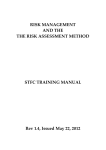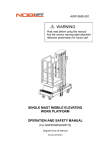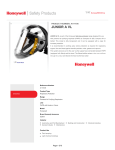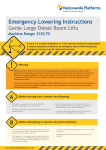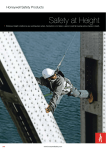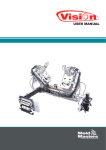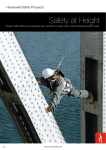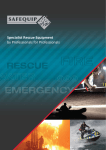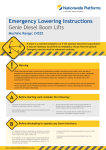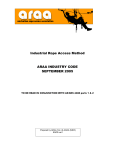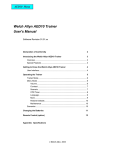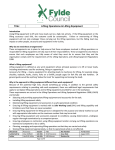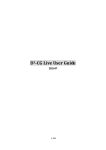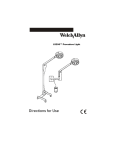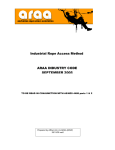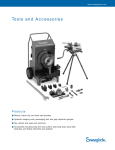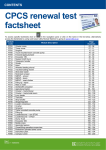Download Skyway Reference Manual
Transcript
Drumbaragh, Kells, Co. Meath Tel: 046 9241771 Fax: 046 9240189 [email protected] Skyway Reference Manual Legislation Health and Safety within the workplace is very much driven by Health and Safety Legislation that is enforced by the Health and Safety Authority, better known as the HSA. There are various pieces of Health and Safety Legislation, Approved Codes of Practice and Guidelines but they all stem from on main piece of legislation which is the Safety Health and Welfare at Work Act 2005. Safety Health and Welfare at Work Act 2005 The main points and focus of the Act is: To secure the health, safety and welfare of people at work; To protect people other than those at work against risks to their health and safety arising out of work activities; To control the keeping and use of explosive or highly flammable or otherwise dangerous substances, and generally preventing people from unlawfully having and using substances; To control the release into the atmosphere of noxious or offensive substances from premises to be prescribed by regulations The term “as far as reasonably practicable” is used throughout safety documentation. The Health and Safety at Work Act 2005 defines it as follows; “(6) For the purposes of the relevant statutory provisions, “reasonably practicable”, in relation to the duties of an employer, means that an employer has exercised all due care by putting in place the necessary protective and preventive measures, having identified the hazards and assessed the risks to safety and health likely to result in accidents or injury to health at the place of work concerned and where the putting in place of any further measures is grossly disproportionate having regard to the unusual, unforeseeable and exceptional nature of any circumstance or occurrence that may result in an accident at work or injury to health at that place of work.” Under the Act the main duties imposed are as follows: Employers’ Duties: The provision and maintenance of plant and systems of work, that are safe and without risks to health. Arrangements for ensuring safety and absence of risks to health in connection with the use, handling, storage and transport of articles and substances. The provision of such information, instruction, training and supervision as is necessary to ensure the health and safety at work of their employees. Rev 0 Oct 2011 1 The maintenance of any place of work under their control, in a condition that is safe and without risks to health, and the provision and maintenance of means of access to and egress from the place of work that are safe and without such risks. The provision and maintenance of a working environment for employees, which is safe, without risks to health and adequate with regard to facilities, and arrangements for their welfare at work. Employers’ Duties: All employees are under a duty to take reasonable care for the health and safety at work of themselves and any other people who might be affected by their acts or omissions, and to co-operate with their employers and others to enable them to comply with statutory duties and requirements. Additionally, they must not intentionally or recklessly misuse anything provided in the interests of health, safety or welfare in the pursuance of any aspect of the health and safety law. Any breach of the requirements imposed by Regulations made under the Act is an offence and may result in prosecution. Approved Codes of Practice provide practical guidance on how to comply with the legal requirements of the Act and subsequent legislation, including regulations. No can be prosecuted for failing to follow the guidance contained within the ACOP; however in choosing not to follow the guidance, defendants must show that they have satisfactorily complied with the requirements made by such in some other way. Risk Assessment: At the heart of the regulations is the requirement for employers to assess what health and safety risks their employees (and others) may be exposed to because of their work. Having made the assessment, the employer must then decide what steps he or she is going to take in order to protect those concerned by complying with relevant health and safety legislation. “Competent” Persons The role of the Competent Person is to management on health and safety, evaluate problems as they arise and suggest solutions to those problems and generally promote health and safety at the place of work. The Competent Person should be able to demonstrate knowledge of current "best practice", be aware of any gaps in training and be able to provide training to fulfill those gaps. This person is appointed by the employer. Rev 0 Oct 2011 2 Health Surveillance In some work situations, there may be a risk of particular health problems or disease developing. Where this is the case then health surveillance (and keeping health records for each individual) will be necessary. Emergency Procedures Under the regulations, employers must set up procedures to be followed in the event of serious and imminent danger. There must be sufficient “competent” people nominated to implement those procedures should the need arise. “11.—(1) Without prejudice to the generality of section 8 , every employer shall, in preparing and revising as necessary adequate plans and procedures to be followed and measures to be taken in the case of an emergency or serious and imminent danger— (a) provide the necessary measures to be taken appropriate to the place of work for first aid, fire-fighting and the evacuation of employees and any other individual present in the place of work, taking account of the nature of the work being carried on and the size of the place of work, (b) arrange any necessary contacts with the appropriate emergency services, in particular with regard to first aid, emergency medical care, rescue work and fire-fighting, (c) for the purposes of implementing the plans, procedures and measures referred to in this section and section 8 (i) designate employees who are required to implement those plans, procedures and measures, and (ii) ensure that the number of those employees, their training and the equipment available to them are adequate, taking into account either or both the size of and specific hazards relating to the place of work.” Information and Training Employees must be informed about any health and safety risks that have been identified and must be told what preventative steps are being taken to protect them. They must also be given adequate and suitable health and safety training. Employees’ Duties The regulations also impose a duty on employees to follow health and safety instructions, and to report to the employer any dangerous situations in the workplace or any shortcomings in health and safety arrangements. Rev 0 Oct 2011 3 Safety, Health and Welfare at Work (General Application) Regulations 2007, Part 4: Work at Height The Regulations do not specify a minimum height requirement for work at height. Part 4 applies to all work activities where there is a need to control a risk of falling a distance liable to cause personal injury. This is regardless of the work equipment being used, the duration the person is at a height or the height at which the work is performed. It includes access to and egress from a place of work. Work at Height Flowchart: Rev 0 Oct 2011 4 Deciding How to Work at Height Safely Is your work considered to be carried out at height, or is it near to an exposed edge? If you are working above ground level, or close to an exposed edge over which you could fall, then will need to make the following assessment. Is there a risk of a person falling a distance liable to cause personal injury? Yes No Is it reasonably practicable to safely carry out the work other than at a height? Yes No Perform the task in a safe manner. Can collective measures be employed? Yes Can you prevent the fall? Yes No Perform the task in a safe manner using Guardrails and / or Safe Working Platforms etc. Use a collective fall protections system to perform the task in safe manner e.g. Safety netting Assess the risk of being suspended in a harness Rev 0 Oct 2011 Perform the task in a safe manner. No Can you prevent the fall? Yes Employ PPE to set up a WORK RESTRAINT or WORK POSITIONING system & perform the task in a safe manner. No Employ PPE to setup a FALL ARREST system & perform the task in a safe manner. Assess the risk of being suspended in a harness 5 Guardrail / Hand Railing Fixed Handrail System Freestanding Guardrail System Hand railing can take many forms such as counterweight systems that do not penetrate the roof, fixed systems that fix into the parapet or existing walls. There are European Standards that have been produced to which specify different types of handrail depending on circumstances and the slop of the roof. Standards: Rev 0 Oct 2011 EN 13374:2004 – Class A, B, C 6 Categories of Work Prior to carrying out work at height careful consideration should be given to ensure that the safest possible solution is chosen. It is not acceptable to select a method of work without first considering the alternatives. A hierarchy of measures exist to assist in this process. By doing so the potential risk to the user will be minimized. At the top of the hierarchy and the safest option is AVOIDANCE, wherever possible avoid unnecessary work at height. This is followed by FALL RESTRAINT then WORK POSITION and finally FALL ARREST. Fall Restraint Fall restraint is the preferred approach to fall protection – it prevents you from falling and from suffering possible injury from the fall arrest system. Work restraint is a technique which uses PPE to prevent a person from entering an area of where a risk of fall from height exists. Work Position Work Positioning is a technique for supporting a person while working by means of PPE in tension, in such a way as to prevent a fall. Fall Arrest Fall arrest is an approach which makes use of items of PPE to stop a falling person under safe conditions. This means that if a worker is in a position such that if he loses control he will fall, he is required to use PPE to limit both the distance and force of that fall. Rev 0 Oct 2011 7 Fall Arrest The European standard for a Fall Arrest System is EN 363. The issued of Personal Fall Protection Equipment (PFPE) should be the last option when trying to control risk. If a risk cannot be adequately controlled utilizing PFPE, then personnel should not be exposed to it. The issue of PFPE and use of Fall Arrest Techniques must only be considered when all other means of controlling the risk of a fall are not reasonably practicable. The use of PFPE and associated techniques will not prevent a fall; only limit the consequences of such. The minimum requirement for a Fall Arrest System is: 1. Workplace Structure 2. Anchor 3. Connector 4. Energy Absorbing Lanyard 5. Connector 6. Full Body Harness worn by user. The system is used in such a way, that the operative is permanently attached to the anchor point whilst he/she is working and the risk of falling is present. The system will arrest a fall should one occur, dramatically reduce the shock generated by such (thereby minimizing the forces that are transmitted to the operative and anchor point) and keep the operative in an upright position (post fall) to limit further injury. When using a Fall Arrest system, the operative must consider the clearance distance required below the working level. There must be a sufficient distance to ensure that the system can fully deploy and arrest a fall without the possibility of the operative hitting the floor. The area within this distance must also be checked to ensure that there are no obstacles that may be hit during a fall. Rev 0 Oct 2011 8 Fall Arrest (Full Body) Harness The European standard for a Fall Arrest (Full Body) Harness is EN 361. A Full Body Harness provides body support and security in the event of a fall. In encapsulating the body, the design of the harness ensures maximum security against the possibility of an operative ‘falling out’. A full body harness is fitted with one or more fall arrest attachment points, into which, energy absorbing lanyard/s should be fitted. The attachment points will always be positioned high at the back of the harness (dorsal) and/or high at the front of the harness (sternal). What makes one worker wear the proper fall protection equipment and use it in the correct manner, while another doesn't? On one hand, workers must receive the proper training on adjusting, inspecting, and maintaining the equipment. On the other hand, no matter how thorough the training, workers might leave the equipment Before purchasing any fall protection equipment, buyers should note that harnesses are not all the same. Everything from harness construction to strap placement can be compared and contrasted. All of these elements do make a difference in the comfort and safety the harness offers the user. Harness buyers and users should also remember that harnesses don't last forever. Harnessing Size Many manufacturers rely on universal sizing, which means a harness should fit the average person. However, universal sizing is designed to fit most, not all, workers. Some harnesses have a minimum adjustment on the chest strap that cannot be used by shorter workers Some harnesses have a minimum adjustment on the chest strap that cannot be used by shorter workers. Rev 0 Oct 2011 9 Fitting a Harness The ability to adjust a harness correctly is important, but some manufacturers' adjustable straps are often too complicated. Employees often have trouble adjusting the leg straps, or they have the D-ring in the back adjusted improperly. In many instances, workers wear harnesses far too loose in order to find a comfortable fit. How safe is that Safety Harness? Most buyers would expect a harness to meet specific standards, but surprisingly, some brands don't meet basic safety standards. Before purchasing fall protection products, ask these questions, and ask for written proof from the manufacturers: Where are the products manufactured? Does the facility have ISO 9001 certification? ISO 9001 certification proves facilities meet strict international standards in quality assurance for design, development, production, installation, and service. Do the products meet EN standards? Insist product labeling this should be a standard element of a harness. Does the fall protection manufacturer have a Statistical Process Control (SPC) program? Fall protection products materials/components. are only as good as the quality of the raw Strapping Down Safety Harness construction is anything but standard. Some harnesses are manufactured without a back strap. In the event of a fall, the person may actually fall out of the back of the harness. Chest straps should be easy to adjust and must withstand a fall without tearing or breaking. In test cases with inferior quality harnesses, some chest straps broke from fall forces. The stronger the straps and stitching, the better the fall protection. Some manufacturers use Velcro for chest straps, but others refuse. "For Miller brand products, we find Velcro is not a suitable substitute for chest hardware because it doesn't hold well enough. When Velcro gets dirty, its holding power is affected," said Ron Cox, Vice President and General Manager of Dalloz Fall Protection-Americas. Rev 0 Oct 2011 10 Inspection and Maintenance A harness should have hardware that's sturdy, but not oversized and awkward. At the same time, the hardware should easily attach to connecting devices. For example, the D-rings on some harnesses are so small that hooking a lanyard can be a tricky process. Harness hardware also poses a hazard if it has sharp edges. The edges can cut into harness webbing or can be positioned in such a way that they dig into the skin in the event of a fall. To protect workers from hardware injuries, the components must be appropriately manufactured and assembled. Hardware with exposed springs should be avoided. Exposed springs, especially on friction buckles, can be easily disabled or removed. Reliable hardware construction is an important feature because friction buckles that are not spring-loaded can easily begin to loosen once the harness has been adjusted to fit. Avoiding Tangled Webs Webbing may seem like an innocuous item that would be similar in all cases, but it varies drastically from brand to brand. Some harnesses use webbing that folds over and tangles, and that can be as frustrating as handling a disagreeable telephone cord. Harness webbing should be sturdy, and the yarns should be tightly woven so the webbing slides easily through the hardware. If webbing snags when it glides under hardware, it can result in cuts to the webbing. Once cut, the harness must be taken out of service. Examining the tensile strength of webbing is also important. After abrasion tests, some webbing begins to fray and pucker bringing the harness to the end of service. Stitching is just as important as the structure of the webbing. The stitching must not rip away during a fall. Harness webbing should resist the effects of sun, heat, and moisture for an extended period of time. If a harness is used in an electrical environment, it must also resist conductivity. If it is used in a harsh chemical environment, the webbing must be able to resist toxic chemical fumes and splashes. Inspecting for Wear In order to ensure a harness will perform the ultimate function it is intended for--saving a life-it must be inspected prior to every use. Remember that all harnesses have a limited life. However, the length of wearable life will vary greatly, depending on the amount of wear it receives and in what type of environment it is worn. For example, a harness worn only indoors, or only a couple of times in a week, will have a much longer life than one worn outdoors every day. A harness worn outdoors endures a variety of environmental forces and may even show visible signs of damage or corrosion in a matter of months. When inspecting your harness, a good rule of thumb is: Any doubts, toss it. Padding is meant to make the harness more comfortable, but if it's difficult to adjust or is made of material that becomes brittle in cold weather, it can become another problem that Rev 0 Oct 2011 11 discourages proper use of the harness. How Does It Work? It sounds too simple to address, but clear, easy-to-read instructions should accompany every harness. In the best case scenario, the instructions will be in more than one language. All of the instructions should include explicit guidelines for usage, maintenance, and inspection. It Adds Up to Safety When purchasing a harness, make sure you are buying the correct harness for the appropriate application. Remember, employees will more readily and properly wear a comfortable harness that easily adapts to lanyards and other connecting devices. The better the harness, the better your company's chances of employees wearing them. That increases safety and regulatory compliance. Most important, it saves lives. Fitting a Harness: Six Easy Steps that Could Save Your Life Harness styles vary. Always refer to the instructions enclosed with your harness. 1. Hold the harness by the back D-ring. Shake the harness to allow all straps to fall in place. 2. If chest, leg, and/or waist straps are buckled, release the straps and unbuckle at this time. 3. Slip the straps over shoulders so the D-ring is located in middle of the back between shoulder blades. 4. Pull the leg strap between legs and connect to the opposite end. Repeat with the second leg strap. If belted harness, connect the waist strap after the leg straps. The waist strap should be tight, but not binding. 5. Connect the chest strap and position in the mid-chest area. Tighten to keep the shoulder straps taut. 6. After all straps have been buckled, tighten all buckles so the harness fits snugly but allows full range of movement. Pass excess strap through loop keepers. Inspection and Maintenance To maintain service life and high performance, you should inspect harnesses frequently. Visual inspection before each use is required. Regular inspection by a competent person for wear, damage, or corrosion should be a part of your safety program. Inspect your equipment daily and replace it if any defective conditions exist. Webbing: Grasp the webbing with your hands 6 to 8 inches apart. Bend the webbing in an inverted "U" as shown. The resulting surface tension makes damaged fibers or cuts easier to see. Follow this procedure the entire length of the webbing, inspecting both sides of each strap. Watch for frayed edges, broken fibers, pulled stitches, cuts, burns, and chemical damage. Rev 0 Oct 2011 12 D-Rings/Back Pads: Check D-rings for distortion, cracks, breaks, and rough or sharp edges. The D-ring should pivot freely. D-ring back pads should also be inspected for damage. Attaching Buckles: Attachments of buckles and D-rings should be given special attention. Note any unusual wear, frayed or cut fibers, or distortion of the buckles or D-rings. Visual Indications of Damage to Webbing and Rope Heat: In excessive heat, becomes brittle and has a shriveled brownish appearance. The fibers will break when flexed. Should not be used above 180 degrees Fahrenheit. Chemical: Change in color usually appearing as a brownish smear or smudge. Transverse cracks when bent over a mandrel. Loss of elasticity. Molten metal or flame: Webbing strands fuse together. Hard shiny spots. Hard and brittle feel. Paint and solvents: Paint that penetrates and dries restricts movement of the fibers. Drying agents and solvents in some paints cause chemical damage. Rev 0 Oct 2011 13 Lanyards and Energy Absorbers The European standard for a Standard Lanyard is EN 354 and Energy Absorbers EN 355. Single lanyards are generally used in various fall arrest situations, and are designed to limit the force of a sustained fall to under 6kN. Double webbing lanyards are generally used to access different areas of a building or tower without being disconnected, and are the perfect way to be connected to an anchorage point at all times. Lanyards feature an external energy absorber, which allows for visual indication of a sustained fall. Lanyards are available as standard with 19mm opening hooks at each end, or with a choice of scaffold hook to suit different attachment applications. For use in fall arrest situations, where the free fall does not exceed 2mtrs. When estimating free fall distances, the extension of the energy absorber must be taken into consideration. The maximum energy absorber deployment is 1.75 mtrs. Choose a webbing lanyard for standard fall arrest applications. The webbing lanyard is lightweight, easy to use and does not retain dirt or grime, making it perfect for every day use. Choose a rope lanyard for situations where working around slightly abrasive surfaces. The rope lanyard is robust and great in heavier duty applications. Choose the Plastic coated wire lanyard for harsh working situations, where the lanyard length may be in contact with sharp edges or hot sparks. This lanyard is very robust and suits extreme working situations. An operative could potentially fall a distance of 4 metres whilst being attached via a 2 metre lanyard; this assuming that he/she has climbed 2 metres above the point where the lanyard is anchored (which amounts to misuse of the equipment). The energy absorber must be capable of limiting the force transmitted to the body after falling 4 metres to less than 6kN (approx. 600kg) when the fall is arrested. Without the energy absorber, a large adult (100kg) falling 4 metres would be subjected to approx. 14kN (1.4 Tonnes) of force, with potentially fatal results. Most energy absorbers will activate when a force of around 2kN (200kg) or above is placed upon them. When activated, the absorber will rip (tear webbing) or slip (friction plate) and extend. The amount of extension will be totally relevant to the load of force place upon them. A full extension will result after a 4 metre fall may be up to 1.75 metres in length. Considering this potential extension, it must be noted that a minimum clearance distance below the anchor point of the lanyard will be required. As a guide only this could be: Rev 0 14 Oct 2011 Length of fall arrest lanyard Length of lanyard extension when activated: Distance allowed for ill-fitting harness: Distance from fall arrest attachment point to operative’s feet Minimum clearance distance required: Rev 0 Oct 2011 2.00m 1.75m 0.50m 1.50m 5.75m 15 The energy absorbing lanyard must always be attached to a suitable anchor point when the risk of falling a distance of 2 metres or more is present. Where an operative is required to make progressive movement, the use of a ‘double’ or ‘twin tail’ lanyard will ensure that constant attachment is maintained. The ‘energy absorbing ‘end of the lanyard should always be attached to the harness (user end)m this attachment being made by the fitted connector. The other end of the lanyard should be attached, via the fitted connector to either: A dedicated anchor point (tested to the appropriate standard), e.g. Safety Eye Bolt A suitable sling or stop wrapped around an anchor point of unquestionable reliability (ensuring that the sling or strop does not significantly increase the length of the lanyard), e.g. suitable structural steel work. A suitable fall arrest device (Pivotloc Shuttle, etc.) forming part of an in-situ safety system, e.g. Pivotloc Ladder, Skyway ladder cable system etc. A fall arrest safety line or Safetraxx System. Unless specifically made to do so, the lanyard should never be wrapped around an anchor point and then attached back onto itself, i.e. ‘ choking’ – in the event of a fall this may promote failure of the connector at relatively low loads. The lanyard must always be attached to an anchor point in as high a position as possible in relationship to the user – an operative attached to a 2 metre lanyard which is anchored 2 metres below, could potentially free fall 4 metres (plus extension etc.). An operative attached with the same, but anchored 2 metres above, will not fall at all. When using a twin tail lanyard, the redundant arm of the lanyard must never be attached to the users harness. Two separate lanyards must never be attached from the user to an anchor point/s at any one time. Never use an energy-absorbing lanyard as a method of suspension Rev 0 Oct 2011 16 Fall Restraint Lanyard When working in Mobile Elevated Work Platforms (MEWP) you should always use a RESTRAINT LANYARD and NOT a FALL ARREST LANYARD. MEWP’S are not designed to arrest a fall and the majority of anchors fitted within are only designed for restraint. You risk hitting the ground if you use a Fall Arrest Lanyard either by the lanyard deploying or by turning the machine over. Only people who are trained to do should be operating a MEWP. Rev 0 Oct 2011 17 Fall Arrest Block / Retractable Type Lanyards The European standard for Fall Arrest Blocks / Retractable Type Lanyards is EN 360 What are Fall Arrest Blocks? A fall arrest block comprises a retractable lifeline made of wire rope, webbing or synthetic fibre rope which is stored on a reel within a protective housing. The reel is spring-biased so as to wind the retractable lifeline in, which ensures that it is always under a light restraining tension and there is the shortest possible length between the housing and the user. The reel incorporates an inertia brake mechanism which allows the lifeline to be slowly extracted and automatically retracted to accommodate the user’s body movements. In the event of a fall, the lifeline is rapidly pulled out of the housing until it reaches a critical velocity (the “lock-on speed”) at which point the brake locks and a clutch mechanism decelerates the user over a short distance. Simple versions of retractable type fall arresters are available which have a maximum working length of 2.4 m. These devices are sometimes known as mini-blocks. These devices work in the same way as normal fall arrest blocks and based around a car seat belt type mechanism, but they do not contain an integral energy absorbing capability. Energy absorption in mini-blocks is achieved by incorporating an external tear-web type energy absorber into the lanyard part, which operates as a normal energy absorbing lanyard. Rev 0 Oct 2011 18 Pre-use Checks There are a range of checks which should be done before any fall arrest block is used. One of the most straightforward is to check the service indicator although other checks are described below. Service or fall indicators on fall arrest blocks There are several mechanisms used to indicate a fall has occurred on these products, activation of which should result in immediate withdrawal from use and return to an authorised service centre: buttons - usually flush with the body but will protrude after a fall hook indicators - coloured bands visible at the top of the hook after a fall or shock load occur. sewn indicators - usually in the hook end of a webbing lanyard indicate if a fall has occurred window indicators - employ coloured warnings to indicate when a device has been used or should be returned for service Do not use these devices if the indicator mechanism shows signs of having previously arrested a fall NOTE: some devices may not contain an indicator mechanism Carrying out a pre-use check Connect the device to a suitable suspension point. Make sure the device is hanging vertically then carry out the following: extend cable/webbing fully and inspect for damage. Do NOT allow an extended cable/webbing to reel in unchecked. Allow it to retract slowly through gloved hands check shackle fixing, connecting hook and swaging of cable end and webbing stitching. check locking mechanism is operating by pulling cable/webbing end sharply. Cable must lock instantly with an audible ‘click’. Interpreting pre-use checks The following information sets out the principal causes of deterioration in lifelines. Wire Type Lifeline crushing - flattened or bent section of cable cutting - damaged strands and broken wires abrasion - localised wear, with outer strands appear flattened and with brighter appearance strand core protrusion - (“bird-caging”) - the central core showing with the outer strands swelling out. (his is usually the result of a shock load) kinking – deformation of cable corrosion - roughness and pitting with broken wire propagating from cracks or pitting electric arcing or heat damage - bluing of surface, fusion of the wire, weld splatters Rev 0 19 Oct 2011 damaged thimbles and ferrules - check secure and free from damage, ensuring other components, e.g. springs, stoppers, and balls are secure and undamaged. connector - ensure the bottom hook, if fitted, is free of excess wear, distortion, cracks, burrs, dents and sharp edges. The gate on the hook must open and close smoothly and must engage the nose of the hook fully. Webbing Type Lifelines Inspect webbing by the same procedure that would be employed for a harness. Rev 0 Oct 2011 20 Connectors The European Standard for a Connector is EN 362 and EN 12275. A Connector is the generic term used to descrive items of equipment that can be opened / closed and provide safe linkages within a safety system, or enable operatives to link themselves directly or indirectly to an anchor. Examples of connectors are: Twist lock karabiner, screw gate karabiner, double action scaffold hook, etc. Twist lock Karabiner Screwgate Karabiner Scaffold Hook When used with a safety system, these connectors must self close and have additional locking mechanism to ensure security. Two deliberate actions have an additional locking mechanism to ensure security. Two deliberate actions by the operator must be required to open a locked connector. The connector must only be loaded along the axis of its length and as close to the spine as possible. It is not designed to withstand side loadings and may fail if subjected to such. Attaching connector to many items of equipment, items of too large a diameter or width or items irregular shape (e.g. angular steel-work) may also load the connector in such a way as to promote failure. Rev 0 Oct 2011 21 Anchor Devices The European Standard for a Connector is EN 795 Possible the most important part of the entire PFPE system, the anchor device must be 100% reliable. This should: Be located at a safe distance above any lower obstacles. Be as vertical as possible The anchor point will form the basis for the whole system. Poor selection may result in a total system failure. Anchor Devices – EN 795 Standard defines 5 categories Temporary Anchor Devices Class B’ Mobile anchorages A temporary transportable anchor device. (e.g. steel strops, scaffold hooks, webbing anchorage slings, tripod and beam grips) *Class B is PFPE Scaffold Hook Wedding Anchorage Sling Class E’ Dead weight anchor A dead-weight anchor for use on horizontal surfaces. Rev 0 Oct 2011 22 Permanent Anchor Devices Class A Fixed anchorages An anchor device designed to be secured to vertical, horizontal and inclined surfaces. (e.g. anchor plate) It could be mounted on wall, inclined roofs, at ground level Class C Horizontal cable lifeline An anchor device employing horizontal flexible anchor lines. (e.g. Skyway Cable System) Rev 0 Oct 2011 23 Class D Horizontal rail systems An anchor device employing horizontal rigid anchor rails. (e.g. Kingspan Safetraxx System by Skyway) All anchor devices are tested to hold a fall. Their minimum resistance is imposed by norms and depends on the recommendations of the manufacturer or installer. WARNING Rev 0 Oct 2011 24 Care & Maintenance of PFPE Care and maintenance of our PFPE is essential for the safe system of work. Cuts, abrasions, burns, and other faults will affect its safety. Multiple cuts have led to energy absorbing lanyards failing before the energy absorber has activated. These accidents could have been prevented by effective pre-use inspections. Inspection Procedure Textile Equipment: Inspect visually for: Cut: A 2mm edge-cut will reduce the webbing strength by as much as 40%. Abrasion: Abrasion across this piece of textile acts in the same way as a cut when it breaks through the wedding threads. Burns: Either from heat source or from contact with corrosive chemicals or materials. In particular, polyamide is susceptible to damage from acids and polyester from alkalis. Ultra-Violet degradation: The main causes are through sources such as welding. Stitching: Inspect for loose, cut, missing, or worn threads. Comfort Pads: Rev 0 Oct 2011 25 Inspect for any sign of rips or wear. Mechanical Devices: (e.g. rope grab, self-retracting lifelines) Correct operation Any Wear Loose Components Distortion Corrosion Cleaning: Basic care of all safety equipment will prolong their durable lifetime and contribute toward the performance of its vital safety function: Proper storage (clean, dry and free from exposure to fumes, corrosive elements or UV) Cleansing to equipment of dirt, corrosives or contaminants. Please refer to user manual to proceed correctly to the cleaning of your PFPE. Mandatory annual inspection: To maintain proper service life and high performance, PFPE must be inspected annually by a competent person. Note: If PFPE is used on a regular basis, 6 months checks are required by a competent person. Equipment Standards Rev 0 Oct 2011 26 Users should be aware that all items of equipment are designed to various applicable standards. A CE mark on a produce indicates that the product conforms to a standard. For your guidance the following are some relevant standards: EN 363 Personal Protective Equipment against fall from height. Fall arrest systems. EN 795 PPE against Falls from Height – Anchor Devices – Requirements & Testing. EN 361 Personal Protective Equipment against fall from height – Full Body Harness EN 362 Personal Protective Equipment against fall from height - Connectors EN 354 Personal Protective Equipment against fall from height - Lanyard EN 355 Personal Protective Equipment against fall from height – Energy Absorbers EN 360 Personal Protective Equipment against fall from height – Retractable type fall arrestors. EN 353-1 Personal Protective Equipment against fall from height – guided type fall arrestors. Part 1 Specification for guided type fall arrestors on a rigid anchorage line. EN 353-2 Personal Protective Equipment against fall from height – guided type fall arrestors. Part 2 Specification for guided type fall arrestors on a flexible anchorage line. EN 358 Personal Protective Equipment against fall from height – Work Positioning System EN 12841 Personal Protective Equipment against fall from height – Work Positioning System – Rope Adjustment devices EN 813 Personal Protective Equipment against fall from height – Sit Harness EN 341 Personal Protective Equipment against fall from height – Descender Devices EN 365 Personal Protective Equipment against fall from height – General requirements for instructions for use and for marking EN 364 Personal Protective Equipment against fall from height – Test Methods Rev 0 Oct 2011 27 CE Marking and Equipment Traceability It is requires that a manufacturer of Personal Protective Equipment (PPE) is able to trace all goods that have been sold. This is the reason that all PPE carries either a batch number or a serial number. You must be able to identify these numbers on your safety equipment so that you will be able to remove items from service if any problems are suspected. You are required to be able to match your equipment directly to its inspection records. Manufacturers Name Product Number Product Description Date of Manufacture (week / year) Serial Number EN Standard Number CE Mark Rev 0 Oct 2011 28 Requirements for Rescue The following information should assist you to fully appreciate why the provision of efficient rescue means is required. Suspension Trauma What is this? A person is suspended without moving, can loose consciousness with only a few minutes, and without rapid intervention, may die. A blow to the head (from a fall or falling object), a medical emergency (fainting, heart trouble…), or simply exhaustion may cause motionless suspension. This is one reason why we must anticipate the situation and have a rescue plan. How can one avoid loosing consciousness? One thing is certain, a user comfortably seated in a harness that is properly adjusted and form-fitting is better equipped to survive a hard fall: avoiding pain and trauma reduces the risk of blacking out in a suspended position. What to do? Therefore a person suspended in a harness, especially if motionless should be assisted / rescued within 20 minutes. This is the reason why, better anticipate and have a rescue plan. Small injuries can lead to BIG problems A small injury such as an injured hand could lead to a person becoming unable to climb down a tower or other structure unaided. In such a case a “rescue” would have to be carried out. Two solutions for rescuing 1. Use of an Automatic rescuing system Can be used to rescue one person at a time (max descent speed: 0.8m/s) Rev 0 Oct 2011 29 2. Use of a Manual rescuing system The descent speed can be activated and regulated through pressure on the handle. (max descent speed: 2m/s) Rev 0 Oct 2011 30 Further Reading & Information www.skyway.ie www.hsa.ie www.irishstatutebook.ie www.hse.co.uk Safety Health and Welfare at Work Act 2005 Safety Health and Welfare at Work (General Applications) Regulations 2007 Part 4 Work at Height EN 795 Equipment Suppliers www.skyway.ie www.spanset.co.uk www.sperian.com Use of Fall Prevention Cable Demonstration http://www.spansetsafeline.co.uk/safeline-system.htm Rev 0 Oct 2011 31
































